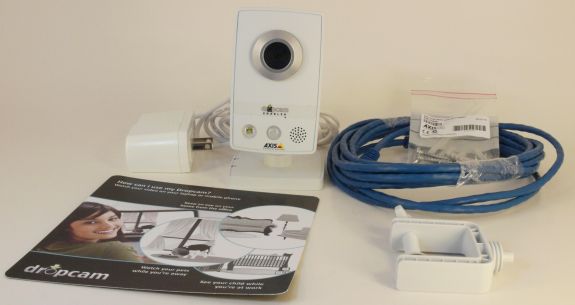Dropcam Echo : Home Security Meets the Cloud
by Ganesh T S on August 11, 2010 7:50 AM EST- Posted in
- Gadgets
- IP cameras
- camera
- camcorder
The Dropcam Echo review unit came in a spartan package. The camera itself was bubble wrapped. There were some mounting aids, a power adapter and an Ethernet cable. Similar to boxed software, the unit was accompanied by a card introducing the Dropcam Echo. The card also had a product key.
I wanted to setup the unit as a non-technical consumer, and decided to follow the directions blindly. Even though my router had a wireless MAC filter, I refrained from adding the Dopcam Echo's wireless MAC ID to the list.
The first direction was to connect the camera to the router using the supplied Ethernet cable. The introduction card directed me to visit www.dropcam.com/start as the next step. The key on the card was entered, and after this, the directions on the website were followed.
I was able to start watching the video from the camera on the site soon after entering the key, but the wireless was still left to be configured. Wireless setup was a must as the Dropcam had to be shifted to a different location, away from the router. The setup page presented me with a list of wireless networks within the reach of the camera, and upon selection of my network, prompted me to enter the network password. For a technical person like me, it was unnerving to find these details displayed and requested on a remote non-secure page, but this is the price one has to pay for a solution that is plug and play. After feedback, Dropcam has now moved these pages to a secure server.
After typing in the network password, the page directed me to lookup the status of the wireless connection by observing the nature of the glow around the lens. A full green would have implied that the wireless connection was successful, but I observed blinking red and green in sequence. Upon clicking the appropriate icon in the page, I was informed that the network password entered could have been incorrect. Failing this, I was supposed to contact Dropcam support. Fortunately, I had requested them to let me know where to find the MAC ID earlier. It turned out to be the SN at the back of the unit. With this MAC ID entered in the wireless filter, I entered the password again, and was presented with a successful wireless connection for the camera. After feedback, Dropcam has added a note about wireless MAC filters to the appropriate page.
All said, I was up and running, with the Dropcam far away from the router (still within the wireless reach) within 10 minutes. I have to say that this is probably the shortest time I have ever spent in setting up any sort of networking gadget.











24 Comments
View All Comments
vgribok - Thursday, August 12, 2010 - link
Security camera footage is just one kind of data generated by households that one wants to make accessible on the web in a secure, authenticated manner while not having to tinker with routers, IPs and such. Real problem is that it's very hard to create any web-based application that is easy enough for a non-technical person to install, and yet secure enough to expose it on the web. That's why there are very few redistributable web applications for consumers and small businesses, while large corporations moved to web based apps long time ago.An ability to build easily-redistributed web-based applications that can be installed inside LANs but still be securely exposed on the web without making non-techy people fiddle with routers, DNS, etc. is the idea being implemented by UltiDev HttpVPN (http://www.httpvpn.com/). It will be paired with Apple-like application store allowing creation and distribution of web applications for customers with no technical skills required to setup secure web hosting on premises, like consumers and small businesses. Home surveillance systems would be a perfect example of who would use HttpVPN.
ipvideomarket - Saturday, August 14, 2010 - link
Dropcam has dozens of competitors with more mature offerings delivering cloud native solutions.For instance, Axis has over 12 partners world-wide supporting Axis's Video Hosting Service.
Also, contrast to Viaas who is delivering a more sophisticated end to end solution.
Finally, a free 'cloud integration' service is offered by Lorex providing no-cost live video monitoring at half the up front cost of Dropcam.
Lonbjerg - Saturday, August 14, 2010 - link
Who in their right mind still thinks a MAC filter gives any form of security?It's spoofed in less than a second...madre mia :/
Anyone still using MAC filtering should turn in their network-man-card.
xtian78h - Tuesday, August 17, 2010 - link
I'm NOT associated with this company before I'm accused of shameless plugging, but given the subject matter I'm surprised no-one has mentioned viaas.com (Video Intelligence As A Service). It looks to be similar to Dropcam.Key differences appear to be - that Dropcam has audio support & iphone monitoring (big plus) - The Viaas cameras come with a micro SDHC slot which allows for the loss of internet connectivity and a can also provide a buffer allowing the user to impose bandwidth / traffic shaping over DSL etc. Other challenges with Viaas - no iphone support.. lack of UK presence (pricing).
Whilst some will doubtless argue, why do you need UK pricing, it's a cloud service after all. When you start shipping cameras from the US and need to guestimate import duty, VAT etc - it just becomes tedious. Likewise with fluctuating exchange rates - services billed only in dollars can rapidly start adding up.